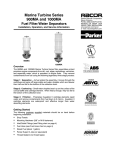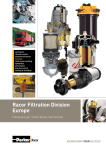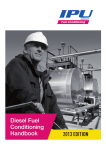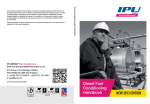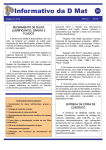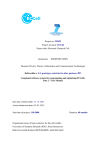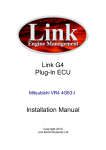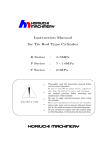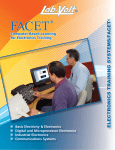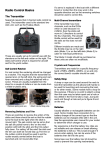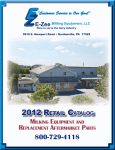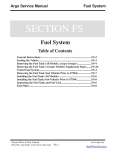Download Racor_Installation_I.. - University of St Andrews
Transcript
900FH and 1000FH Turbine Series Fuel Filter/Water Separators Installation, Operation, and Service Information Overview Parker Hannifin Corporation Racor Division PO Box 3208, 3400 Finch Rd. Modesto, CA 95353 USA 209--521--7860/800--344--3286 www.parker.com/racor e--mail: [email protected] The 900FH and 1000FH Turbine Series filter assemblies protect precision engine components from dirt, rust, algae, asphaltines, varnishes, and especially water, which is prevalent in engine fuels. They remove contaminants from fuel using the following legendary three stage process: Stage 1 -- Separation As fuel enters the assembly, it moves through the centrifuge and spins off large solids and water droplets, which are heavier than fuel, and fall to the bottom of the collection bowl. Stage 2 -- Coalescing Small water droplets bead--up on the surface of the conical baffle and cartridge element. When heavy enough, they too fall to the bottom of the collection bowl. Stage 3 -- Filtration Proprietary Aquabloc II cartridge elements repell water and remove contaminants from fuel down to 2 micron. Aquabloc II cartridge elements are waterproof and effective longer than water absorbing elements. Turbine Series filter assemblies are designed to be installed on the vacuum side of the fuel transfer pump for best efficiency (see the Installation Diagram on page three). Adjustable one--piece clamp--type mounting brackets, with grade 5 fasteners, are included for ensured durability. The 900FH uses one mounting bracket and the 1000FH uses two. The see--thru contaminant collection bowl allows the operator to check for water and solid contamination at a glance. 900FH Getting Started The following customer supplied materials should be on hand before beginning installation. S S S S S S S Shop Towels Diesel Fuel (about 1 gallon) Thread Sealant (no thread tapes) Parker Super O--lube (or equivalent) Fuel Hose (see Fuel Hose chart on page 4) Mounting Hardware (3/8” or M10 fasteners) Inlet/Outlet Fittings (see Fitting chart on page 4) 1000FH Mounting Information (no scale) 900FH 1000FH Clearance for 3/8” (M10) fasteners. Clearance for 3/8” (M10) fasteners. 11.0” (27.9 cm) Adjustable to 13.5” (34.3 cm) 4.5” (11.4 cm) 4.5” (11.4 cm) 10.9” (27.7 cm) Note -- mount the filter assembly as close to vertical (V) as possible. Do not exceed 10o from vertical or the assembly may not function properly. 5.0” (12.7 cm) Brackets are adjustable from 2.0” to 8.8” (5.1 to 22.4 cm) 10o V 10o 90o Installation Instructions When positioning the filter assembly: S FH filter assemblies should be installed on the vacuum side of the fuel transfer pump for optimum water separating efficiency. See ’Installation Diagram’ on the next page. S Keep fuel line restrictions to a minimum. Locate the FH filter assembly between the horizontal planes of the bottom of the fuel tank and the inlet of the fuel pump, if possible. If the FH filter assembly is installed in an application where the fuel tank is higher than the filter, a shut--off valve must be installed between the tank and the FH filter assembly INLET. This will be used when servicing the replacement element. Before installing the filter assembly: S S S S Obtain good ventilation and lighting. Maintain a safe working environment. The engine must be off for installation. DO NOT smoke or allow open flames near the installation. Installing the filter assembly: S Completely remove any vacuum side filters in the fuel line between the fuel tank and the fuel pump. This is where the FH filter assembly will mount. Leaving these filters in place will add to the fuel line restriction. Filter heads cast into the engine or that are non--removable or hard piped should be serviced with a new element and left in place. S Keep fuel flow restriction values to a minimum. Always use the maximum size fuel hose possible. Do not make sharp bends with flexible fuel hose as kinks may occur. Avoid the use of two 45o elbow fittings where one 90o elbow will work. S When routing hose, avoid surfaces that will move, have sharp edges, or will get hot (such as exhaust piping). 900FH and 1000FH Installation Diagram A Vacuum Side Installation is Recommended Fuel Tank Pressure Side lnstallation Fuel Tanks Above the Filter Do not exceed 39’ (11.9 m) of head feet or 15 PSI. Maintain a clearance above the filter assembly of at least 5” (12.7 cm) for the 900FH and 10” (25.4 cm) for the 1000FH for element removal. A shut--off valve is recommended when the fuel tank is mounted higher than the filter. Inlet Fuel Tank Ideal Vacuum Side lnstallation Outlet Engine Valve 1 A check valve (with light to no restriction) is recommended to enable the system to maintain prime. Optional fuel transfer pump not to exceed 15 PSI (103 kPa) or maximum flow rate of the filter. NOT ideal -- pumps emulsify water hendering filter performance. Fuel Transfer Pump (IDEAL vacuum side installation). Maintain a clearance below the filter assembly of at least 2” (5.1 cm) for draining and servicing the bowl. Fuel Tank Vacuum Side lnstallation Fuel Tanks Below the Filter Do not exceed 5’ (1.5 m) of lift or 4 inches of mercury (inHg) of inlet piping restriction. Valve 2 Valve 3 Optional Bypass Installation and Operation The optional bypass installation allows the user to service the filter without shutting down the engine. Valves Unit On--line: Unit Off--line: 1 Open Closed 2 Open Closed 3 Closed Open Racor Plated Steel Fittings Description T1 (SAE J1926) T2 Tube or Hose Size SAE O--ring (T1) to JIC 37o Male Flare (T2) Elbow 7/8”--14 UNF 7/8”--14 UNF 3/4”--16 UNF 7/8”--14 UNF 8 10 9020--10--8 9020--10--10 SAE O--ring (T1) to JIC 37o Male Flare (T2) Straight 7/8”--14 UNF 7/8”--14 UNF 3/4”--16 UNF 7/8”--14 UNF 8 10 911--O10--F8 911--O10--F12 SAE O--ring (T1) to Female NPT (T2) Straight 7/8”--14 UNF 7/8”--14 UNF 1/2”--14 NPT 3/4”--14 NPT 8 12 913--O10--H8 913--O10--H10 913--O10--H12 SAE O--ring (T1) to Hose Barb (T2) Elbow 7/8”--14 UNF 7/8”--14 UNF 7/8”--14 UNF 1/2” Hose Barb 5/8” Hose Barb 3/4” Hose Barb 8 10 12 911--O10--H8 911--O10--H10 911--O10--H12 SAE O--ring (T1) to Hose Barb (T2) Straight 7/8”--14 UNF 7/8”--14 UNF 7/8”--14 UNF 1/2” Hose Barb 5/8” Hose Barb 3/4” Hose Barb 8 10 12 Part Number 9010--10--8 9010--10--10 Picture (No Scale) T2 T1 T2 T2 T2 T2 T1 T1 T1 T1 Note: T1 is the side of the fitting that will attach to the FH filter housing. Additional fitting options may be available from a Parker dealer. Call 1--800--C--PARKER (1--800--272--7537) for the dealer nearest you. Racor Fuel Hose Racor fuel hose is fire resistant and meets SAE J1527 Type A class and SAE J1942 standards. This hose delivers test proven performance in a wide operating temperature range, constant working pressure in popular sizes, long--lasting reinforced construction, kink and cut resistance, and compatibility with a variety of standard fittings. Part Number Hose ID Working Pressure Burst Pressure Min. Bend Radius CGH--10 1/2” (12.5 mm) 500 PSI (3.5 MPa) 2000 PSI (14 MPa) 2 1/4” (55 mm) CGH--12 5/8” (16 mm) 500 PSI (3.5 MPa) 2000 PSI (14 MPa) 2 3/4” (70 mm) CGH--16 7/8” (22 mm) 500 PSI (3.5 MPa) 2000 PSI (14 MPa) 3 1/2” (90 mm) Note -- additional sizes are available -- call Racor at 1--800--344--3286. Additional Features S S S S High--tensile steel wire braid. No--Skive -- does not require the removal of outer cover to install. USCG--rated for gasoline, diesel, lube oil and hydraulic systems. Working temperature of --4oF to +212oF (--20oC to +100oC). Priming Instructions 1. 2. 3. 4. 5. 6. 7. Remove the T--handle and lid from the top of the filter assembly. Fill the filter assembly with clean fuel. Lubricate lid gasket and T--handle O--ring with clean fuel or motor oil. Replace the lid and T--handle and tighten snugly by hand only -- do not use tools. If applicable, refer to the equipment Operator’s Service Manual to complete the fuel priming procedure. Start engine and check for fuel system leaks. Correct as necessary with engine off and pressure relieved from filter assembly. Service Instructions Draining Water: Frequency of water draining is determined by the contamination level of the fuel. Inspect or drain the collection bowl of water daily or as necessary. The collection bowl must be drained before contaminants reach the top of the turbine or when the Water Detection Module (optional) indicates it’s time to ’drain water’. Vacuum Applications / Installations: 1. 2. 3. Close the inlet valve (or valve #1) and open the self--venting drain on the bottom of the bowl. Close the drain after all the water and contaminants have been evacuated -- DO NOT leave the drain open too long as it will eventually completely drain the entire filter assembly of water AND fuel. Follow ’Priming Instructions’. Pressure Applications / Installations: 1. 2. Open the self--venting drain on the bottom of the bowl to evacuate water and contaminants with a suitable collection container in place. Head pressure will push any water and contaminants out of the drain while keeping the filter primed. Close the drain after all the water and contaminants have been evacuated -- DO NOT leave the drain open too long as it will eventually completely drain the entire filter assembly of water AND fuel, and possibly drain the entire tank. Element Replacement: Frequency of element replacement is determined by the contamination level of the fuel. Replace the elements every 10,000 miles, every 500 hours, every other oil change, when the vacuum gauge (optional) reads between 6 to 10 inches of mercury (inHg), if power loss is noticed, or annually, which ever comes first. Note -- always carry extra replacement elements as one tankful of excessively dirty fuel can plug a filter. Use only genuine Racor Aquabloc II replacement elements. All Applications: 1. 2. 3. 4. 5. Bypass filter assembly with bypass valves, if applicable. Remove the T--handle and lid. Remove the element by holding the bail handles and slowly pulling upward with a twisting motion. Dispose of properly. Replace old lid gasket and T--handle O--ring with new seals (supplied with new element). Lubricate both seals with motor oil or diesel fuel before installation. Refer to ’Priming Instructions’, otherwise, fill the unit with clean fuel, then replace the lid and T--handle and tighten snugly by hand only -- do not use tools. Note -- above ground tanks or transfer pump applications may use head pressure to prime the filter assembly. Installing Optional Water Detection Components Note -- Racor electrical options are for use with diesel applications only. Water Sensor FH filter assemblies can be ordered with a water sensor installed at the factory. The following instructions are for FH filter assemblies that do NOT have a water sensor already installed. All water sensors must be used with a special Racor electronic detection module to function properly. Due to the variety of detection modules available, they are sold separately and installation instructions are supplied with each kit. See chart below for part numbers and descriptions. 1. Drain the FH filter assembly completely. 2. Take out the water sensor plug on the side of the bowl and discard properly. 3. Lubricate the water sensor O--ring with Parker Super O--lube or equivalent. 4. Thread the water sensor into the probe port on the side of the bowl. Tighten snugly. 5. Attach the Racor detection module to the wire leads of the water sensor. Specific instructions for this step are included with each detection module. 6. Prime the FH filter assembly by filling with fuel. 7. Start engine and check for leaks. Correct as necessary. Water Detection Modules Racor water detection modules are available in a wide selection for various installation requirements. Under dash, in--dash and remote mount, these solid--state units may be used with any Racor water sensor. They are manufactured using the highest quality materials and are all 100% electronically tested. An electronic detection module analyzes electrical resistance at the water sensor and determines if water is present. If so, the detection module operates to indicate water, based on its features listed below. All units reset automatically after water is removed (unless specified). Below are some of our more popular modules, others are available. Part Number Description Voltage RK 12870 Under--dash mount. Light and audio. Illuminates and sounds when water is detected. Plastic enclosure measures 1.4” square by 1.25” deep. Power draw is 1 milliamp. 12 vdc RK 12871 Same as above. 24 vdc RK 20726 In--dash mount. Light and audio. Red ’DRAIN’ lamp illuminates continuously and horn sounds momentarily when water is detected. Initial power--up self diagnosis feature and circuit protection included. Plastic 2” gauge. Power draw is 3 milliamps for 12 vdc and 13 milliamps for 24 vdc. 12 or 24 vdc RK 20725 Under--dash mount. Light only. Green ’ON’ lamp illuminates with power and red ’DRAIN’ lamp illuminates when water is detected. Initial power--up self diagnosis feature and circuit protection included. Plastic enclosure measures 2.75” by 1.0” by 1.5”. Power draw is 10 milliamps. 12 vdc RK 20725--24 Same as above. 24 vdc Picture Installing An Optional Fuel Heater Note -- Racor electrical options are for use with diesel applications only. The in--filter heater is a cold weather starting aid with an internal automatic thermostat that turns the heater ON when the fuel temperature drops below 50oF (10oC) and turns OFF when the fuel reaches 80oF (27oC). Heat is supplied in the FH filter assembly just below the replacement element to melt wax crystals and allow fuel to pass through the element for quick, easy starting. The 300 watt heater is available in 12 or 24 vdc and is operated by turning the ignition switch ON for a minimum of five minutes prior to starting the engine. FH filter assemblies can be ordered with a heater installed at the factory. If you are adding a heater to a filter assembly that does not already have one, refer to the installation instructions that come with the heater. Follow the directions below to hook up the heater wire leads to your engine. Customer Supplied Items: 1. Heater power demand is 25 amps for 12 vdc and 13 amps for 24 vdc. Due to the power demand, an additional relay is recommended for the safest method of installation. Racor offers two relay kits available from your Racor distributor. Part numbers are RK 11861 (for 12 vdc) and RK 11862 (for 24 vdc). These kits include an in--line fuse holder (and fuse) and the RK 11862 kit also includes a resistor. Use the 25 amp fuse with a 12 vdc system and the 15 amp fuse (and resister) with a 24 vdc system. 2. An ON--OFF toggle switch may be used to control power to the heater relay. This allows the operator to cut power to the heater relay during summer use. 3. All wires should be 14 AWG (American Wire Gauge) minimum. Installation: 1. Either heater wire may be used for Hot (+) or Ground (--). 2. Wire / terminal connections should be soldered and crimped. 3. Run wires in protected locations. Avoid hot surfaces and places that could pinch or rub on the wires. Manual ON--OFF Switch (Optional) Fuse Block Relay 1 Amp Fuse B2 C4 E3 A5 *Resistor *Fuse Ignition Switch Inlet Port + -Battery *Use a resistor and 15 amp fuse with 24 vdc heaters. Replacement Parts Part Number Description 1 T--handle and O--ring Kit T--handle O--ring RK 11--1945 11350 1 2 3 2 RK 11--1927--01 Lid and Lid Gasket Kit 11007 Square Cut Gasket (Lid and Bowl) 3 RK 19002--03 RK 11021--03 900FH -- Outer Cylinder 1000FH -- Outer Cylinder 5 4 RK 11--1931 RK 11--1930 900FH -- Return Tube 1000FH -- Return Tube 6 5 RK 11815--103 Body Clamp Bracket 8 6 900FH: 2040SM--OR 2040TM--OR 2040PM--OR 2 Micron Element w/ Seals 10 Micron Element w/ Seals 30 Micron Element w/ Seals 4 7 15 16 17 10 1000FH: 2020SM--OR 2020TM--OR 2020PM--OR 2 Micron Element w/ Seals 10 Micron Element w/ Seals 30 Micron Element w/ Seals 7 RK 11--1953 Valve, Spring & O--ring Kit 8 RK 11--1800--01 12 vdc Heater w/ Body Feed--thru RK 11--1800--02 24 vdc Heater w/ Body Feed--thru 9 RK 21067 RK 11--1679 Body Feed--thru Assy (for heater) Body Feed--thru Plug (not shown) 10 11007 Square Cut Gasket (Lid and Bowl) 11 RK 11028B Checkball and Seal 12 RK 11--1939 Turbine Centrifuge / Conical Baffle 13 RK 11--1938 See--thru Bowl w/ Drain & Plug 14 RK 32204 RK 22838 Water Sensor Water Sensor Plug 15 RK 11--1776 Body, 7/8”--14 16 RK 11037A Bowl Ring, 5” Diameter 17 RK 11542 Capscrew Kit (4) 18 RK 30476 Self--venting Drain Additional Parts RK 11--1952 RK 31605 (various) 9 FH Assembly Seal Kit Parker Super O--lube Racor Additives (see chart on next page) 11 12 13 18 Racor Diesel Biocide (16 oz. bottle) 14 Additive Diesel Biocide Diesel Conditioner Plus+ Diesel Winter Plus+ Part Number Size Treatment ADT 2116 16 oz. Bottle 1,280 Gallons ADT 2201 1 Gallon Bottle 10,240 Gallons ADT 1116 16 oz. Bottle 320 Gallons ADT 1201 1 Gallon Bottle 2,560 Gallons ADT 4116 16 oz. Bottle 128 Gallons ADT 4201 1 Gallon Bottle 1,024 Gallons Benefits S S S Concentrated formula S S S Enhances engine performance S S S Inhibits waxing, icing and gelling Kills bacteria and fungi Prevents corrosion Stabilizes the fuel Quieter engine operation Protects down to --30 30oF (--34 ( 34oC) Enhances engine performance Specifications Basic Models 900FH 1000FH Maximum Flow Rate 90 GPH (341 LPH) 180 GPH (681 LPH) Port Size (SAE J1926) 7/8”--14 UNF 7/8”--14 UNF Replacement Elements: 2 micron 10 micron 30 micron 2040SM--OR 2040TM--OR 2040PM--OR 2020SM--OR 2020TM--OR 2020PM--OR 5 in. (127 mm) 2 in. (51 mm) 10 in. (254 mm) 2 in. (51 mm) Height 17.0 in. (432 mm) 22.0 in. (559 mm) Depth 6.0 in. (152 mm) 6.0 in. (152 mm) Width 7.0 in. (178 mm) 7.0 in. (178 mm) 6.0 lb (2.7 kg) 10.0 lb (4.5 kg) Clean Element Pressure Drop 0.30 PSI (2.07 kPa) 0.43 PSI (2.97 kPa) Maximum Allowable Pressure1 15 PSI (103 kPa) 15 PSI (103 kPa) 305 ml 305 ml Yes Yes Yes Yes Minimum Service Clearance Above assembly Below assembly Weight (dry) Water In Bowl Capacity Available Options:2 Water Sensor Heater Operating Temperature --40o to +255oF / --40o to +121oC Special Notes 1 Pressure 2 Not installations are applicable up to the maximum PSI shown. Vacuum installations are recommended. for use on gasoline applications. Troubleshooting Note -- Correct external fuel leaks immediately! These conditions will result in reduced engine performance such as: hard starting, stalling, reduced power and other associated problems. New filter installations must be filled with fuel and the fuel system must be adequately primed following the engine manufacturer’s recommendations, if applicable. Existing installation difficulties are usually associated with improper priming procedures or damage to the unit or fuel system. The result is either internal air suction or external fuel leakage. Diagnosis should be in the following steps: 1. 2. 3. 4. Check the fuel tank level and make sure any fuel delivery valves are in the open position, as applicable. Ensure the T--handle, bowl fasteners and fuel fittings are tight. Also verify that the bowl drain is closed. If the Racor element is new, check potential restriction at the fuel tank draw tube. An in--tank strainer may be plugged. Review some of the workings of the units below to possibly uncover other solutions. Correct Application -- It is very important that the FH filter assembly is not ’under specified’ for the application. The maximum fuel flow rating of the FH filter assembly must not be exceeded. Doing so will reduce efficiency and de--gas (pull air from) the fuel. Filter Elements -- Replacement elements are available in 2, 10 and 30 micron ratings. Filtration needs are based on application, fuel quality, maintenance schedules and operating climates. A simple rule to remember is -- the finer the filtration, the more frequent the filter change. Always carry extra replacement elements with your equipment as one tankful of excessively contaminated fuel can plug an element. When clogged to the maximum capacity, elements will have a brown to black color or tar like contaminants may be present -- this is normal. An appearance of a multi--colored slime (which may have a foul odor) is an indication of microbiological contamination. This condition must be treated immediately. Severe conditions must be corrected by a repair facility. Note -- Never operate the filter assembly without the element in place -- the element safety valve will not expose the outlet hole on the fuel return tube if the element is removed. Instead, punch the emergency tab on the top of the element and leave in place. Puncturing the emergency tab will bypass all filtration and send unfiltered fuel to your engine. Service the element as soon as possible to avoid harmful contaminants flowing downstream to the engine. Water Sensors -- This feature alerts the operator of a high--water condition. The bowl is then drained of water at the earliest convenience. Note -- a Racor water detection module is needed to work with the in--bowl sensor. The unit should activate when the water reaches the sensor tips (and when they measure between 47,000 and 100,000 ohms of resistance, depending on the detection module used). If not, the tips may be fouled with a coating. Remove the sensor and clean the tips with a cloth. Run a jumper wire between the tips with the ignition ON to test the system. Difficulties usually lie in the wire connections, power source, or an independent ground. Heaters -- In--filter heaters are starting aids only, but may be left on during cold operations. The 300 watt heater is an extremely reliable option, but MUST be powered via a relay switch due to the initial amperage surge at start--up: 25 amps at 12 vdc and 12.5 amps at 24 vdc . They do not activate unless the fuel is below 50oF (10oC) and automatically deactivate at 80oF (28oC). Heater Testing -- The heater can only be tested when the thermostat is closed (fuel temperature is below 50oF or 10oC). With a voltmeter attached to external wiring, and engine off, power should drop when heater is switched on. (Option -- remove the heater and place it in a freezer until the temperature is under 50oF (10oC). Remove the heater and repeat the above test). Troubleshooting All Racor FH filter assemblies are 100% tested to ensure a leak--proof, quality product. Note -- Correct external fuel leaks immediately! In the event difficulties are experienced with your filter assembly or a problem appears to prevent the engine from running smoothly, follow the quick--help illustration below or refer to the procedures on the previous page. Note -- Apply Parker Super O--lube (part number RK 31605) or equivalent to all seals at major attachment points to maintain integrity, seal elasticity, to fill small voids and provide protection from degradation. Perform the following checks with the engine OFF (and applicable valves closed). For replacement parts, refer to the Replacement Parts section of this manual. Damaged, worn, or dirty seals will allow air ingestion. Inspect and replace all seals as needed. Clean the sealing surfaces of dirt or debris every time the element is replaced. Hand tighten the T--handle only! Do not use tools. If the element is changed or the assembly drained for any reason, repriming the assembly (filling with fuel) may be necessary. Fill to just above the top of the element before replacing the lid. If the carriage bolt has been loosened, do not overtighten it as this may distort the cylinder roundness. The four self--tapping capscrews must not be overtightened to avoid stripping out the body threads. After disassembly, start threads by hand prior to using tools. Specification: 55--65 in.lbs. The hollow aluminum check ball floats up against the seal when the fuel is stopped thus preventing fuel bleed--back. If your unit looses prime, inspect upstream hose connections first otherwise, disassemble the unit and inspect the seal and ball. Air bubbles or fuel leakage appearing from the drain may indicate that the drain is not closed completely or that the seal has been clogged with contaminants. Tighten or disassemble and inspect. Specification: 30--35 in.lbs. If the self--venting drain will not work when opened, it may be clogged. Cycle the drain (open--close) or attach a hose and briefly apply air (<2--3 PSI) to dislodge the contaminants. The element should be replaced every 10,000 miles, every 500 hours, every other oil change, annually, or at the first indication of power loss, whichever occurs first. For Construction and Agricultural use, change the filter every 300 hours. See ’Heaters’ on previous page. SAE O--ring ports should have a smooth angled seat for sealing. Do not scratch this surface. Check O--ring for damage. The heater feed--thru O--ring must not be damaged or swollen. Tighten snugly. Specification: 15--20 in.lbs. Air bubbles appearing from the turbine are an indication of an upstream leak between the Racor inlet and the fuel tank pick--up tube. Drain water (if present) before it gets to this level. A water sensor plug is installed if the water sensor option is not selected. Tighten snugly. Specification: 15--20 in.lbs. The water sensor (if equipped) should activate when water contacts the tips. Air bubbles or fuel leakage appearing from the sensor may indicate that the it is loose or that the O--ring is damaged. Tighten or disassemble and inspect. Specification: 15--20 in.lbs. RACOR LIMITED WARRANTIES STATEMENT All products manufactured or distributed by Racor are subject to the following, and only the following, LIMITED EXPRESS WARRANTIES, and no others: For a period of one (1) year from and after the date of purchase of a new Racor product, Racor warrants and guarantees only to the original purchaser--user that such a product shall be free from defects of materials and workmanship in the manufacturing process. The warranty period for pumps and motors is specifically limited to ninety (90) days from date of purchase. A product claimed to be defective must be returned to the place of purchase. Racor, at its sole option, shall replace the defective product with a comparable new product or repair the defective product. This express warranty shall be inapplicable to any product not properly installed and properly used by the purchaser--user or to any product damaged or impaired by external forces. THIS IS THE EXTENT OF WARRANTIES AVAILABLE ON THIS PRODUCT. RACOR SHALL HAVE NO LIABILITY WHATSOEVER FOR CONSEQUENTIAL DAMAGES FLOWING FROM THE USE OF ANY DEFECTIVE PRODUCT OR BY REASON OF THE FAILURE OF ANY PRODUCT. RACOR SPECIFICALLY DISAVOWS ALL OTHER WARRANTIES, EXPRESS OR IMPLIED INCLUDING, WITHOUT LIMITATION, ALL WARRANTIES OF FITNESS FOR A PARTICULAR PURPOSE (EXCEPT FOR THOSE WHICH APPLY TO PRODUCT OR PART THEREOF THAT IS USED OR BOUGHT FOR USE PRIMARILY FOR PERSONAL, FAMILY, OR HOUSEHOLD PURPOSES), WARRANTIES OF DESCRIPTION, WARRANTIES OF MERCHANTABILITY, TRADE USAGE OR WARRANTIES OR TRADE USAGE. WARNING Failure or improper selection or improper use of the products and/or systems described herein or related items can cause death, personal injury and property damage. This document and other information from Parker Hannifin Corporation, its subsidiaries and authorized distributors provide product and/or system options for further investigation by users having technical expertise. It is important that you analyze all aspects of your application and review the information concerning the product or system in the current product catalog. Due to the variety of operating conditions and applications for these products or systems, the user, through its own analysis and testing, is solely responsible for making the final selection of the products and systems and assuring that all performance, safety and warning requirements of the applications are met. The products described herein, including with limitation, product features, specifications, designs, availability and pricing, are subject to change by Parker Hannifin Corporation and its subsidiaries at any time without notice. The following statement is required pursuant to proposition 65, applicable in the State of California: ’This product may contain a chemical known to the State of California to cause cancer and reproductive toxicity’. Racor’s policy is one of continual improvement in design and manufacturing to insure still finer products; therefore, specifications, equipment and product information, while correct at the time of publication, is subject to change without notice. Copyright, Parker Hannifin Corporation, July 2003. Part Number 12960 Revision A












